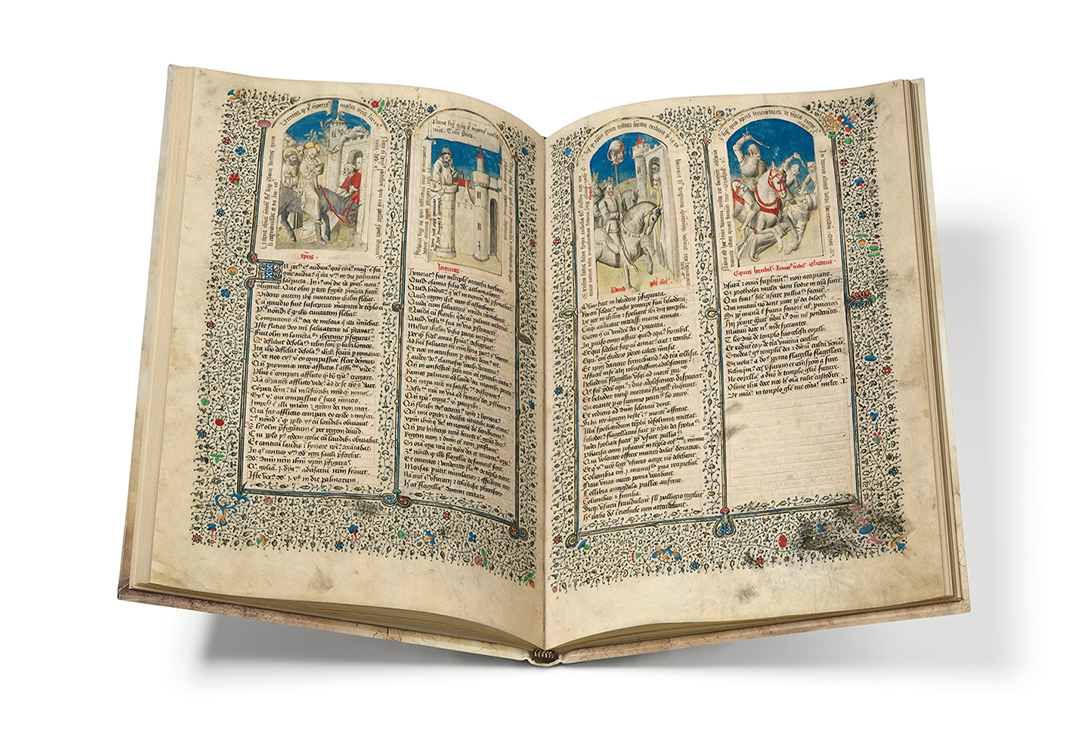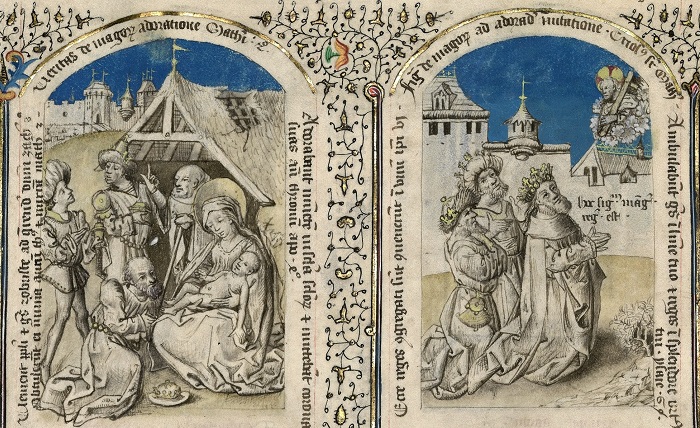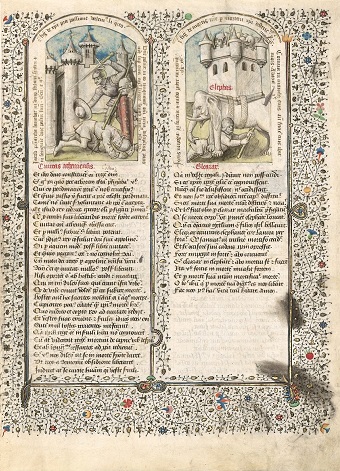The Speculum Humanae Salvationis from Einsiedeln Abbey
A Series of 176 Miniatures on Biblical History
“The Codex 206 kept in our library is among the most beautiful manuscripts of the ‘speculum humanae salvationis’ from the Late Middle Ages. The very first glance at the book surprises the viewer with its vibrant colours and gilded ornaments. I am truly pleased that due to the outstanding quality of the facsimile edition the splendour of this impressive testimony of book illumination is now accessible to a wider public.” (P. Justinus Pagnamenta OSB, librarian of Einsiedeln Abbey)
Heilsspiegel aus Kloster Einsiedeln
The Mirror of Human Salvation from Einsiedeln Abbey: The Manuscript
An Artist Working for Noble Patrons
The Mirror of Salvation takes its name from Einsiedeln Abbey where it is kept today. It was produced around 1450/60, possibly in Paris or in the southern Netherlands, where the art of book illumination and panel painting flourished under the dukes of Burgundy. This exceptionally rich manuscript is associated with a master who must have been familiar with both the work of the Netherlandish panel painter Roger van der Weyden and the books of hours painted by the Boucicaut Master. In addition, there are clues indicating that for a period of time the artist was in the service of Dreux Budé, the influential notary and secretary to King Charles VII and King Louis XI of France.
A New Type of Book
The Mirror of Human Salvation from Einsiedeln Abbey ranks among the most beautiful examples of a new type of book created in the early 14th century. From the very beginning, it was designed as a manuscript combining text and illustrations. The subject is the salvation of Man by Christ and the Virgin Mary, whereby the events of the Old Testament are directly correlated with those of the New. Each event of the New Testament is prefigured, or foretold, by three antecedents from the Old Testament or Antique mythology. The typological concept implies that the redemption of Man through Christ fulfils the promise given to the people of Israel. The Mirror of Salvation was aimed at members of the clergy and educated lay people alike.
In the Library of Einsiedeln Abbey
The Mirror of Salvation from Einsiedeln Abbey entered the library of Einsiedeln Abbey only in the course of the 18th century. Before this date, there are no shelf marks, and no notes as to its origin or ownership. How the manuscript came to Einsiedeln remains in the dark. The splendid Mirror of Salvation is first mentioned in the “Diarium Helveticum” by Augustin Calmet, Abbot of Senones Abbey in the Vosges. On a journey to Switzerland in order to visit a number of libraries, he also went to Einsiedeln. In the manuscript catalogue published in 1899, Father Gabriel Meier gave a first, more detailed description of the manuscript. Ever since, the volume has carried the shelf mark Cod. 206.
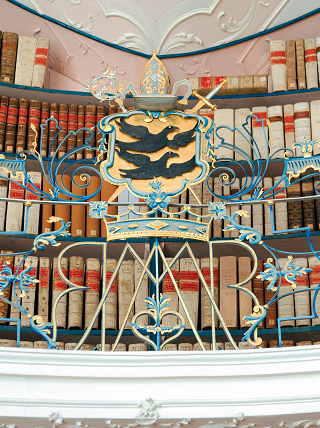
Heilsspiegel aus Kloster Einsiedeln
Under the Magnifying Glass: Pen Drawings full of Vitality and Attention to Detail
Heilsspiegel aus Kloster Einsiedeln
The Mirror of Human Salvation from Einsiedeln Abbey: The Edition
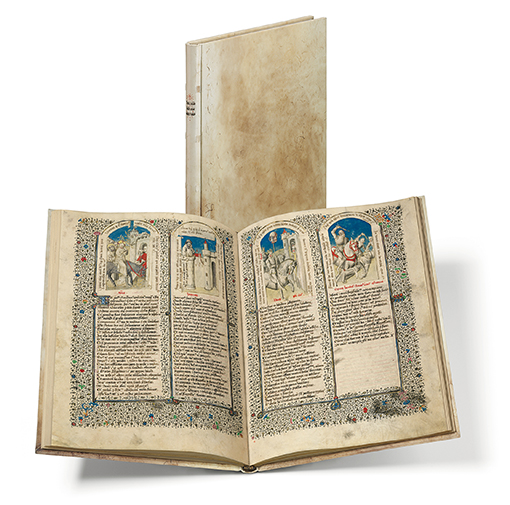
The Manuscript and the Facsimile at a Glance
The Mirror of Salvation from Einsiedeln Abbey is one of the most lavish volumes of this genre. Every page is enlivened not only by delicate colours in the miniatures and border decorations, but also by sparkling gold in the initials, frames and fine foliate sprays. The facsimile edition is true to the original by employing a new special paper that emulates the qualities of parchment. This gives the viewer turning the pages of the facsimile an entirely novel tactile experience, heightened by a rustling sound.
Manuscript: Einsiedeln, Stiftsbibliothek, Cod. 206
Date of Origin: c. 1450/60
Place of Origin: Paris or Burgundian Netherlands (Brussels?)
Dimensions: c. 36.0 x 27.4 cm
Extent: 92 pages (46 leaves)
Artist: Master of the Mirror of Human Salvation from Einsiedeln Abbey = Master of Dreux Budé (?)
Patron: unknown
Illumination: 176 miniatures, 57 three-line initials in opaque colours on a gold ground, decoration of fine foliate sprays on all pages, fine semi-grisaille painting
Binding: parchment binding
Commentary Volume for the Facsimile Edition by Hans-Walter Stork / Gregory T. Clark
Print run: 680 copies
Heilsspiegel aus Kloster Einsiedeln
Enjoy Viewing 10 Sample Pages:
A Glance at the Facsimile
The sequence from the Mirror of Salvation from Einsiedeln Abbey presented here consists of pp. 44–53. Each page is surrounded by a rich border of fine foliate branches. The two columns are separated by large gold bars, and a miniature is inserted into the upper third of each column.
Each pair of open pages is designed to form a typological unit. The left-hand scene on the verso side shows a scene from the New Testament (antitype), to which the three scenes from the Old Testament, placed at the right and on the opposite recto side, refer as its prefigurations (types). The miniatures shown here are from chapters 22 to 26 including the antitypes from Christ’s Passion.
Heilsspiegel aus Kloster Einsiedeln
A Challenging Production: fac simile

Presented in its True Light
The reproduction of the Mirror of Salvation from Einsiedeln Abbey starts with the photographing of every single manuscript page on the premises of the abbey library. For this purpose, a special digital system has been developed. A special lighting technique is used to capture both the sparkling gold leaf in the initials and the fine foliate sprays of the borders as well as the softly shimmering shell gold. The utmost care has to be taken in reproducing the various shades of gray in the grisaille drawings in order to accentuate their vividly modelled character, rather than simply give an overall plain gray impression.
The Rare Art of Bookbinding
True to the original, the facsimile is entirely bound in parchment – a skill currently known only to a very few bookbinders! The challenge is that parchment is difficult to handle and requires a special binding technique. Since every piece of parchment is different in quality, the bookbinder has to select with care those parchments for the facsimile edition which match the colour of the original Mirror of Salvation from Einsiedeln Abbey as closely as possible. Other production steps require just as much precision and experience. The calligrapher needs a steady hand to label the spine.
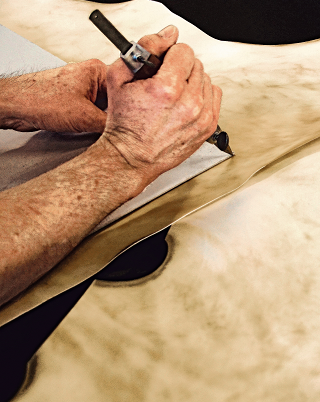
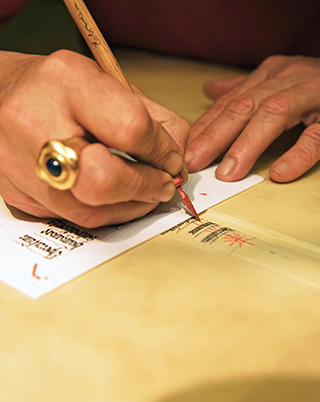
Heilsspiegel aus Kloster Einsiedeln
The Facsimile Folder for the Edition
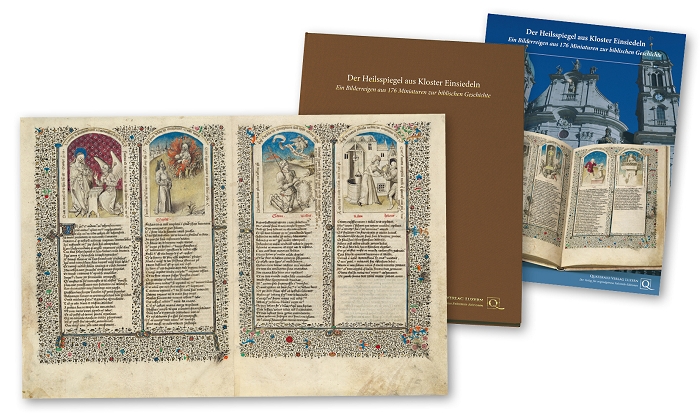
Heilsspiegel aus Kloster Einsiedeln




